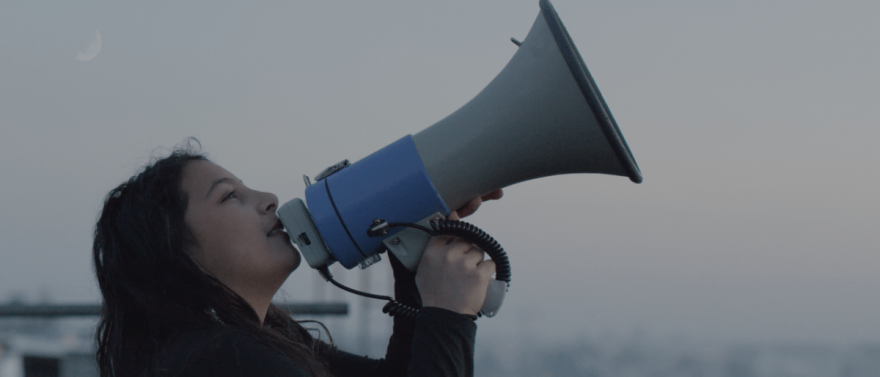Lunch with La république des enchanteurs (The Republic of Enchanters)
Interview with Fanny Liatard and Jérémy Trouilh, directors of La république des enchanteurs (The Republic of Enchanters)
What inspired you to make this film? Is it part documentary?
We were invited to shoot a film with the inhabitants of a neighborhood in Nantes for the “Dans Mon Hall” project organized by the production company De l’Autre Côté du Périph’ and the Confédération Syndicale des Familles (CSF).
The idea was to invite ten directors to ten different neighborhoods in France to make three movies of three minutes with the inhabitants after spending only two weeks in the neighborhood. That’s how we ended up in the village of Dervallières in Nantes in December 2015. We spent the first week meeting as many of the inhabitants as possible, through local organizations and in the streets. We would talk to them for a few minutes, or have longer interviews back on the CSF premises. With this material, we had three days to write a script, two days to practice, and two days to shoot. It was an incredible, intense and beautiful experience, thanks to the connections we made with the people from the neighborhood. If La république des enchanteurs is fiction, the film draws its inspiration from reality, from the stories of the people we met, from their feelings and from the overall atmosphere we experienced in this place.
What interested you in use of music, songs, and repeated and arranged sounds to create a melody?
The three chapters of our story form a single “republic”. We wanted each of the three parts to have in common an introduction in music or sound, indirectly announcing the short story to come, like a narrator before he plunges into a book.
It is women who dance and slam “A bit more air beneath our skirts!” in the first film, a young girl who chants the Arabic lyrics of a song by Fairuz (“We and the moon are neighbors”) in the second one, and the child who whispers words of reassurance in Romanian in the third. Thus, the film is composed of three portraits, and we knew from the moment we wrote it that the soundtrack would play a fundamental role in unifying these three stories and making one coherent film. We wanted each part to have its own multicultural sounds, expressed through singing, slamming, chanting or dancing. These sounds blend together to form a common hymn that echoes the values of this republic of enchanters: liberty, poetry, equality, fraternity, courage and gentleness. Nathan Blais, a composer with whom we are accustomed to working, wrote a musical theme that appears in several declinations, with different instruments used in accordance with the chapters. Nathan gave the music wintery, magical and sometimes melancholic tints that we wanted to emphasize. In addition to this original music, we used a song by Fairouz that we love. We had that melody in our minds when writing and it inspired us greatly with its poetry and warmth. There is also a slam that Fanny wrote a few years ago that we had the women of the first chapter read in canon. Lastly, editing work was done with everyday sounds to render them melodic. Alexander Kalashnikov, sound editor, and Paul Jousselin took care of the mixing and helped us a lot with this creative sound work.
La république des enchanteurs portrays a benevolent, open society, as if “enchanted”. Why did you want to show this vision of the world?
Maybe because the two of us are optimistic by nature. And above all, because the neighborhood where we shot the film, les Dervallières, is a place where local organizations are strong, where there are a lot of people committed on a daily basis to making their neighborhood a pleasant place to live together, and we wanted to emphasize that community. And also, because we made this film in a particular context that surely must have influenced us. La république des enchanteurs was shot two weeks after the 13 November attacks. Necessarily, at the moment we wrote those stories, we were still reeling from the horror of those attacks, and also from the fear of conflation, the fear that there would be an increase in the stigmatization that certain neighborhoods and the people who live there experience. So, perhaps as a reaction to this, we decided to make a radically optimistic film. At the same time, there is still a hint of melancholy, of winter, and of an almost sad gentleness in these three stories. But our first intention was to show a neighborhood whose soul was woven together by its wonderful inhabitants. We thought a lot about the magical realism of South America in making this film, and about that literature that mixed magical and dreamlike visions and a naturalistic approach in certain social contexts. Our neighborhoods are places of rare wealth, where interacting cultures weave strong bonds. We are painting a picture of the somewhat utopian society of our dreams, but it is above all a film inspired by what really exists. Benevolence, openness, and poetry are there, many of the citizens carry this within them, and we want to give them thanks.
La république des enchanteurs also personifies the town through faces, smiles and words. How important was the human aspect of this film?
Towns are above all a confluence of people that is denser than other places, with public spaces where people cross paths, meet each other, argue. It is this space that we first encounter and that we wanted to explore. In our previous film, Gagarine, the architecture was a character in itself which played a central role in the story. For La république des enchanteurs, we had a limited amount of time to get to know the neighborhood, and the first things that struck us were the faces on which the stories of unique lives took shape. We were surprised by the spontaneity of some of the people we interviewed in the neighborhood. Their accounts were often hard, sometimes funny, but always rich and astonishing. We wanted to show this beauty, and provide a place of expression for these people who are not always heard. Fiction gives us that space, because it allows us sidestep and tell these stories that are sometimes too personal.
You also play with the staging of the characters, as well as contrast and lighting effects, creating a fantastical and surrealistic feeling to the story. Was this intentional, and what place does this atmosphere and imagery have in relation to the narration and the script?
La république des enchanteurs was shot in a neighborhood with people who had never acted before, and with a deadline that left us almost no time to rehearse. However, we knew from the beginning that we wanted to create a film marked by a fictional aesthetic quality, even an unreal feeling, in order to sublimate these characters anchored in reality. To do this, our staging was also inspired by magical realism. Even if our republic is perhaps a bit less fantastical than it would be in a film by Jodorowsky, he is still an example of a director who we greatly admire, because his freedom and his vision inspire us and give us courage. We also thought a lot about Kieslowski, with his beautiful film Dekalog, shot in a Polish neighborhood in the middle of winter. Obviously it’s uncomparable, but in terms of imagery and lighting, let’s say that Kieslowski, or Carax, influenced us in the way we shot the town and captured people in their urban spaces, and helped us conceive the staging for this film.
During filming, which was done very quickly and with a very small team, we used simple tools to create this discrepancy between the real and the dreamlike. We had a good camera and good optics, fairly soft. The smoke machines, the 2:35 format, and the accentuated blue light in certain scenes are all effects that helped us in this direction. Victor Seguin, the photography director with whom we worked in our first film, is always very attentive to our intentions, and always gets very involved in the scouting, the editing and the filming. His suggestions are important, and despite the limited time frame, he does everything to capture an important shot, always looking for a solution, even getting in the back of a shaking truck to capture a travelling shot alongside a horse covered in Christmas lights! It is in large part thanks to him that we were able to create this surrealistic atmosphere. Then the editing work, with Daniel Darmon, allowed us to make some pretty radical choices, taking shots of the sea, playing with the sounds of the town, the sea, bodies in action, and intertwining voices on pastel images.
Any cinematic coups de cœur in the past year you’d like to tell us about?
Toni Erdmann by Maren Ade was our greatest coup de cœur this year. And for very different reasons, we would like to mention The Revenant, The Embrace of the Serpent and I, Daniel Blake.
If you’ve already been to Clermont-Ferrand, could you share with us an anecdote from the festival? If not, what are your expectations for this year?
Last year, Gagarine, our first film, was shown in the program for schools, and it was impressive to know that every morning, our film was seen by more than 1000 young middle and high school students. We had the opportunity to meet some of them, and the exchanges were very spontaneous. We are happy that La république will also be shown to students this year. We hope for more great discussions with this new story. And we’re also excited about the Colombian panorama being offered – we are both very attached to this country.
La république des enchanteurs is being shown in National Competition F1.








